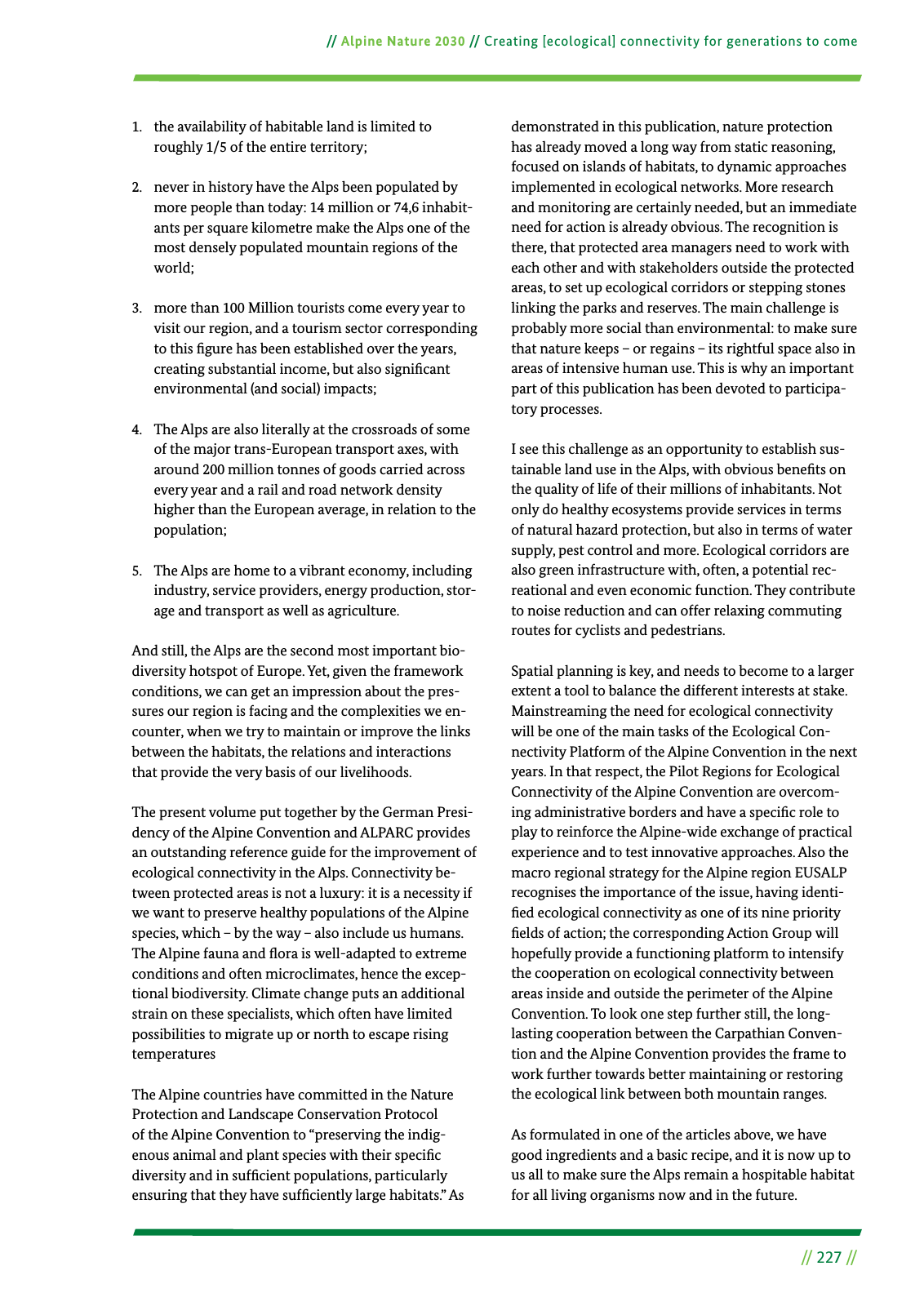227 Alpine Nature 2030 Creating ecological connectivity for generations to come 1 the availability of habitable land is limited to roughly 1 5 of the entire territory 2 never in history have the Alps been populated by more people than today 14 million or 74 6 inhabit ants per square kilometre make the Alps one of the most densely populated mountain regions of the world 3 more than 100 Million tourists come every year to visit our region and a tourism sector corresponding to this gure has been established over the years creating substantial income but also signi cant environmental and social impacts 4 The Alps are also literally at the crossroads of some of the major trans European transport axes with around 200 million tonnes of goods carried across every year and a rail and road network density higher than the European average in relation to the population 5 The Alps are home to a vibrant economy including industry service providers energy production stor age and transport as well as agriculture And still the Alps are the second most important bio diversity hotspot of Europe Yet given the framework conditions we can get an impression about the pres sures our region is facing and the complexities we en counter when we try to maintain or improve the links between the habitats the relations and interactions that provide the very basis of our livelihoods The present volume put together by the German Presi dency of the Alpine Convention and ALPARC provides an outstanding reference guide for the improvement of ecological connectivity in the Alps Connectivity be tween protected areas is not a luxury it is a necessity if we want to preserve healthy populations of the Alpine species which by the way also include us humans The Alpine fauna and ora is well adapted to extreme conditions and often microclimates hence the excep tional biodiversity Climate change puts an additional strain on these specialists which often have limited possibilities to migrate up or north to escape rising temperatures The Alpine countries have committed in the Nature Protection and Landscape Conservation Protocol of the Alpine Convention to preserving the indig enous animal and plant species with their speci c diversity and in suf cient populations particularly ensuring that they have suf ciently large habitats As demonstrated in this publication nature protection has already moved a long way from static reasoning focused on islands of habitats to dynamic approaches implemented in ecological networks More research and monitoring are certainly needed but an immediate need for action is already obvious The recognition is there that protected area managers need to work with each other and with stakeholders outside the protected areas to set up ecological corridors or stepping stones linking the parks and reserves The main challenge is probably more social than environmental to make sure that nature keeps or regains its rightful space also in areas of intensive human use This is why an important part of this publication has been devoted to participa tory processes I see this challenge as an opportunity to establish sus tainable land use in the Alps with obvious bene ts on the quality of life of their millions of inhabitants Not only do healthy ecosystems provide services in terms of natural hazard protection but also in terms of water supply pest control and more Ecological corridors are also green infrastructure with often a potential rec reational and even economic function They contribute to noise reduction and can offer relaxing commuting routes for cyclists and pedestrians Spatial planning is key and needs to become to a larger extent a tool to balance the different interests at stake Mainstreaming the need for ecological connectivity will be one of the main tasks of the Ecological Con nectivity Platform of the Alpine Convention in the next years In that respect the Pilot Regions for Ecological Connectivity of the Alpine Convention are overcom ing administrative borders and have a speci c role to play to reinforce the Alpine wide exchange of practical experience and to test innovative approaches Also the macro regional strategy for the Alpine region EUSALP recognises the importance of the issue having identi ed ecological connectivity as one of its nine priority elds of action the corresponding Action Group will hopefully provide a functioning platform to intensify the cooperation on ecological connectivity between areas inside and outside the perimeter of the Alpine Convention To look one step further still the long lasting cooperation between the Carpathian Conven tion and the Alpine Convention provides the frame to work further towards better maintaining or restoring the ecological link between both mountain ranges As formulated in one of the articles above we have good ingredients and a basic recipe and it is now up to us all to make sure the Alps remain a hospitable habitat for all living organisms now and in the future

Hinweis: Dies ist eine maschinenlesbare No-Flash Ansicht.
Klicken Sie hier um zur Online-Version zu gelangen.
Klicken Sie hier um zur Online-Version zu gelangen.